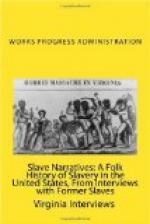“The quarters where we lived on the plantation called Randolph Manor were built like horse stables that you see on race tracks; they were 1-1/2 story high, about 25 feet wide, and about 75 feet long, with windows in the sides of the roofs. A long shelter on the front and at the rear. In front, people would have benches to sit on, and on the back were nails to hang pots and pans. Each family would have rooms according to the size of the family. There were 8 such houses, 6 for families and one for the girls and the other for the boys. In the quarters we had furniture made by the overseer and colored carpenters; they would make the tables, benches and beds for everybody. Our beds were ticking filled with straw and covers made of anything we could get.
“I have a faint recollection of my grandparents. My grandfather was sold to a man in South Carolina, to work in the rice field. Grandmother drowned herself in the river when she heard that grand-pap was going away. I was told that grandpap was sold because he got religious and prayed that God would set him and grandma free.
“When I was ten years old I was put to work on the farm with other children, picking weeds, stone up and tobacco worms and to do other work. We all got new shoes for Christmas, a dress and $2.50 for Christmas or suits of clothes. We spent our money at Mr. Randorph’s store for things that we wanted, but was punished if the money was spent at the county seat at other stores.
“We were allowed fat meat, corn meal, black molasses and vegetables, corn and grain to roast for coffee. Mother cooked my food after stopping work on the farm for the day, I never ate possum. We would catch rabbits in guns or traps and as we lived on the rivers, we ate any kind of fish we caught. The men and everybody would go fishing after work. Each family had a garden, we raised what we wanted.
“As near as I can recall, we had about 150 sheep on the farm, producing our own wool. The old women weaved clothes; we had woolen clothes in the winter and cotton clothes in the summer. On Sunday we wore the clothes given to us at Christmas time and shoes likewise.
“I was married on the farm 1863 and married my same husband by a Baptist preacher in 1870 as I was told I had not been legally married. I was married in the dress given to me at Christmas of 1862. I did not get one in 1863.
“Old Silas Randolph was a mean man to his slaves, especially when drunk. He and the overseer would always be together, each of whom carried a whip, and upon the least provocation would whip his slaves. My mistress was not as mean as my master, but she was mean There was only one son in the Randolph family. He went to a military school somewhere in Virginia. I don’t know the name. He was captured by the Union soldiers. I never saw him until after the war, when he came home with one arm.
“The overseer lived on the farm. He was the brother of Mrs. Randolph. He would whip men and women and children if he thought they were not working fast.




